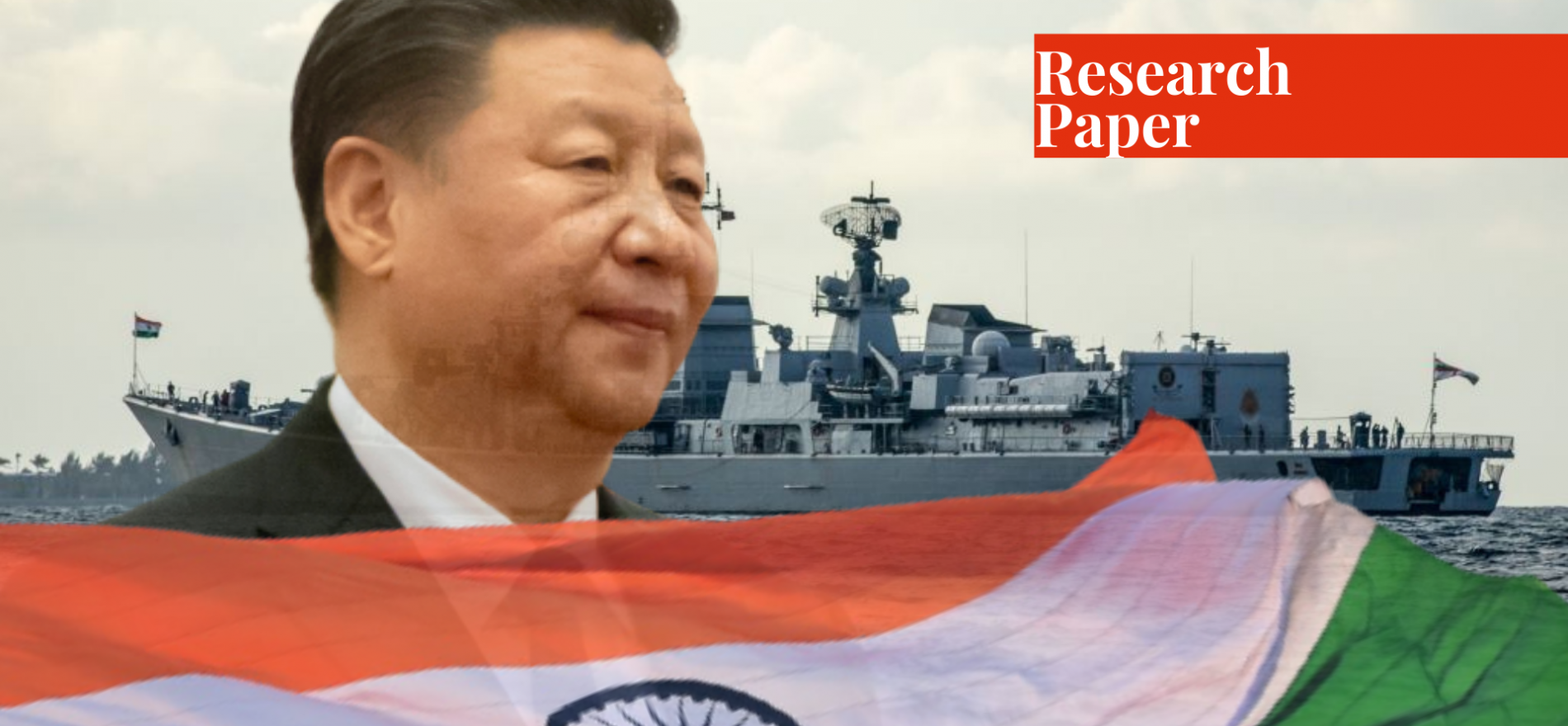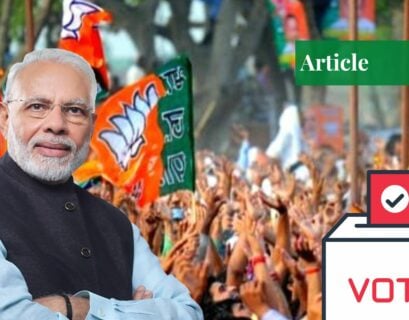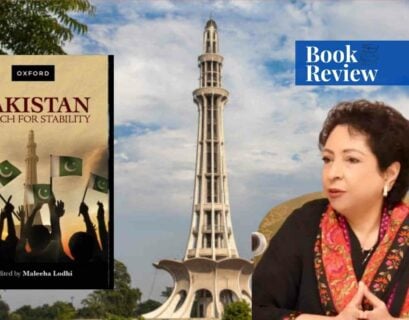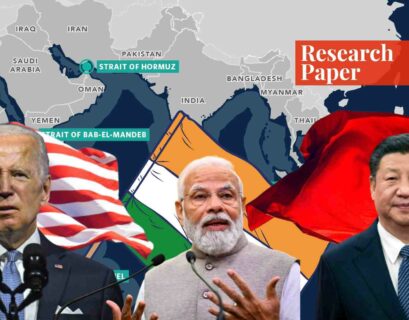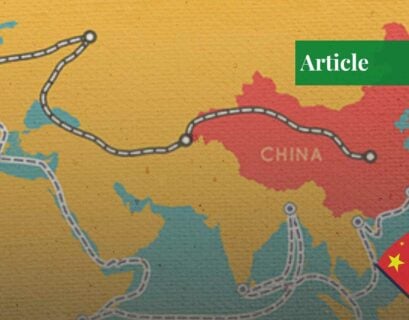Samrah Aslam is a defence strategist holding an M.Phil Degree in Defence and Strategic Studies from Quaid i Azam University.
Introduction
China is trying hard to dominate in Indian Ocean Region to secure its Sea Lines of Communication (SLOC) for the protection and safety of trade activities to maintain high economic growth. On the other hand, India is an emerging economy with the same needs as that of China, with the clear ambition to dominate the Indian Ocean.
This desire to dominate the sea has culminated into strategies to find ways and means to exercise this influence overseas. A strategic paradox is a result because of the uncertain competition between the two economic giants in this region.1
Geographical and Historical Significance
The Indian Ocean is the third-largest water body covering about 18% of the earth’s surface. Geographically, Asia lies in the north, Africa is in the west, Australia is in the east, and Antarctica in the south of the Indian Ocean.
The important choke points in the Indian Ocean are the Strait of Hormuz, Bab al Mandeb, the Strait of Malacca, the Lombok Strait, and the Palk Strait along with the Arabian Sea, Andaman Sea, Bay of Bengal, Gulf of Aden, Mozambique Channel, Persian Gulf, Red Sea, Gulf of Oman and Gulf of Aden.
Suez Canal is also an important chokepoint linking the Mediterranean Sea with the Indian Ocean. The presence of these important chokepoints and strategically significant water bodies within the Indian Ocean contributes largely to the significance of the Indian Ocean as a whole. Historically, the Indian Ocean has been a hub of civilizations and maritime trade for thousands of years.
Numerous ancient civilizations of Africa and Asia played a role in the exploration of the Indian Ocean. The Maldives was also an important ancient civilization that flourished on the shores of the Indian Ocean. The Indian Ocean witnessed the Muslim dynasty, Ming Dynasty, and then the colonial periods under the Portuguese, French and British.
The SLOCs in the Indian Ocean are amongst the most significant choke points in terms of strategic importance and relevance. The Indian Ocean links the Middle East, Africa, and East Asia with Europe and America by important sea routes and linkage points.
China’s Strategic Interests and Ambitions in the Indian Ocean
China is one of the strongest economic giants in the world with the fastest growing economy that is likely to surpass the American economy in the coming decade. While pursuing this large economy at a high rate, China’s interests have increased massively in the world’s affairs because of the strategic and economic interests they hold.
The Indian Ocean is an important playground for political and economic activities in the 21st century.2 China’s interests in the Indian Ocean largely involves energy security and access to new markets for the purpose of finding alternative sea routes to reduce the over-reliance of China’s energy supplies over Malacca Strait and for securing maritime trade activities by holding control over or having an influence on the important choke points in the Indian Ocean.3
The foremost interest of China is in its energy security that has compelled China to spread its wings across the world, especially in the Indian Ocean and the Pacific Ocean. The energy security of China is significant to meet the long-term needs of China’s industrial and economic ventures. Secondly, the geostrategic importance of the Indian Ocean is also an important factor to determine the standing of China in the world.4
Chinese Strategies
China is opting for a long-term, sophisticated, and intelligently crafted strategy to protect its maritime ambitions and interests in the world to overcome its energy vulnerabilities and secure its energy supplies. Joseph Nye has defined soft power as, “getting others to want the outcomes you want, that co-opts people rather than coerces them.”5
China has been pursuing a robust soft power strategy to build its image in different parts of the world especially in East Asia, South Asia, and Africa to gain brotherly cooperation to secure China’s interests in the world.6 China has been propagating the Chinese expeditions in the Indian Ocean as a legacy of the historical voyages during the Ming Dynasty.
It pursues the “Chinese Grand Strategy” in the form of the “String of Pearls Strategy”. Pearls are the important sea bases in the Indian Ocean and joining lanes with these pearls make it the String of Pearls. China is redefining the role of the People’s Liberation Navy by increasing the size of fleets and weapons it operates. In recent times, China has developed a massive number of frigates and destroyers along with naval ships.7
India’s Interests and Ambitions in the Indian Ocean
The Indian Ocean is considered to be the home ocean for India and India’s maritime interests entirely depend on securing SLOCs in the Indian Ocean.8 India’s interests in the Indian Ocean include securing and protecting important choke points in the Indian Ocean; developing friendly relations with the Indian Ocean littoral states especially with the members of the Indian Ocean Rim Association; and securing India’s energy supplies and expansion of Indian markets in the Indian Ocean Rim to counter Chinese influence.9
Indian Strategies
In 2015, the Indian Prime Minister decided to take aggressive measures to counter China’s increasing influence in the Indian Ocean region and so visited Sri Lanka, Mauritius, and Seychelles. In addition, India proclaimed its “Look East Policy”. Under this policy of cooperation, India deliberately built relations with the South Asian and Southeast Asian Nations to dominate the SLOCs in the Indian Ocean.
India’s Maritime Strategy under the Indian Maritime doctrine published in 2004 and updated in 2015 clearly underlines the aspirations of India to gain command of the Indian Ocean as India’s Ocean. Indian Maritime Strategy is based on the idea of “Ensuring Secure Seas” in which India has mentioned the dominance over the Indian Ocean as the inherited right of India.
A Real Dilemma or a Constructed Thought?
Both China and India are Asian economic giants with seemingly the same energy desires and needs. This desire to dominate is creating a kind of strategic dilemma where both of the states with the help of allies and partners are pursuing hegemonic policies in the Indian Ocean region. India is a powerful state in this region and with the help of the USA, it can become a potential competitor of China.10
In addition, Chinese think tanks view India’s naval and maritime ambitions beyond the Indian Ocean and as a threat to China’s strategic interests as a whole. This Indian strategy to expand cooperation and relations with Southeast Asian Nations carries geostrategic implications and creates a threat perception for China.11
Competition between India and China over the Indian Ocean choke points is a matter of debate as parity between India and China in terms of economy and military is not possible. Although, India has the energy requirements on the same lines as China, yet India can never compete with China in Indian Ocean dominance that is evident in the success of BRI and the String of Pearls strategy.12
China has developed plenty of bases throughout different points of the Indian Ocean, undermining Indian interests to counter this influence.13 Despite this unequal power paradigm in Indian Ocean politics, India has been developing its relations in ASEAN areas and South Asia. India has propagated itself as the keeper of the Indian Ocean, but China, too, largely depends on the Indian Ocean’s SLOCs for its energy supplies.14
This paradox can lead to regional rivalry culminating in the global power competition with the involvement of other big players such as the United States, Russia, the European Union, and Australia.15
Conclusion
The study reveals that the Indian Ocean is a pivot for world politics in contemporary and most probably in the future as well because of the strategic significance it holds. China and India are the most important players in Indian Ocean politics, each having its own specific strategic interests in the Indian Ocean.
China’s baseline interests are to secure its energy supplies and minimize the reliance on the Malacca strait for trade activities and energy supplies. India’s interests lie in the fact of geographical proximity of India with the Indian Ocean as India is said to be the largest Indian Ocean littoral state.
The study concludes that the overlapping interests of India and China have created a strategic paradox in Indian Ocean politics where both states are trying to develop their navies for the protection of the important choke points in the Indian Ocean for the safe flow of trade. This paradox is actually an alarm for future competition or rivalry because both the states are increasingly moving towards economic growth that demands more and more footholds over the sea lines.
Endnotes
1 Hatcher, Jaime. 2013. China’s Growing Indian Ocean Martime Time Interests: Sowing the Seeds of the Conflict? Sea Power Center.
2 Khurana, Gurpareet S, 2016. “China as an Indian Ocean Power: Trends and Implications.” Maritime Affairs: Journal of the National Maritime Foundation of India (Taylor & Francis Group) 12 (1): 13-24.
3 Bastos, Maria. 2014. “The Indian Ocean and the Rise of a Multi-polar World Order: The Role of China and India.” Policy Perspectives 11 (2): 17-28. https://www.jstor.org/stable/10.13169/polipers.11.2.0017.
4 Choudhury, Avinandan, and P. Moorthy. n.d. “Strategic Maritime Triangle in the Indian Ocean: An Emerging Indo-US Naval Entente.” India Quarterly (SAGE Publications) 74 (3): 305-325.
5 Nye, Joseph. 2004. Soft Power: The Means to Success in World Politics.
6 Choudhury, Avinandan, and P. Moorthy. n.d. “Strategic Maritime Triangle in the Indian Ocean: An Emerging Indo-US Naval Entente.” India Quarterly (SAGE Publications) 74 (3): 305-325.
7 Frankel, Francine R. 2011. “THE BREAKOUT OF CHINA-INDIA STRATEGIC RIVALRY IN ASIA AND THE INDIAN OCEAN.” Journal of International Affairs1 (Journal of International Affairs Editorial Board) 64 (2): 1-17. https://www.jstor.org/stable/24385531.
8 Hatcher, Jaime. 2013. China’s Growing Indian Ocean Maritime Time Interests: Sowing the Seeds of the Conflict? Sea Power Center.
9 INDIAN OCEAN.” Journal of International Affairs1 (Journal of International Affairs Editorial Board) 64 (2): 1-17. https://www.jstor.org/stable/24385531
10 Zhu, Zhiqun. 2011. “China-India Relations in the 21 st Century: A Critical Inquiry.” Indian Journal of Asian Affairs ( Manju Jain) 24 (1/2): 1-16. https://www.jstor.org/stable/41950508.
11 Haldar, Sayantan. 2018. “Mapping Substance in India’s Counter-strategies to China’s Emergent Belt and Road.” Indian Journal of Asian Affairs (Manju Jain) 311 (1/2): 75-90. https://www.jstor.org/stable/10.2307/26608824.
12 Brewster, David. 2018. “India and China as Sea: Competition for Naval Dominance in the Indian Ocean.” SADF COMMENT (116).
13 Frankel, Francine R. 2011. “THE BREAKOUT OF CHINA-INDIA STRATEGIC RIVALRY IN ASIA AND THE INDIAN OCEAN.” Journal of International Affairs1 (Journal of International Affairs Editorial Board) 64 (2): 1-17. https://www.jstor.org/stable/24385531.
14 Holmes, James R., and Toshi Yoshihara. 2008. “China and United States in The Indian Ocean: An Emerging Strategic Triangle.” US Naval War College, China’s Maritime Studies Institute, Newport, 21.
15 Zhu, Zhiqun. 2011. “China-India Relations in the 21 st Century: A Critical Inquiry.” Indian Journal of Asian Affairs ( Manju Jain) 24 (1/2): 1-16. https://www.jstor.org/stable/41950508.
Bibliography
- Bastos, Maria. 2014. “The Indian Ocean and the Rise of a Multi-polar World Order: The Role of China and India.” Policy Perspectives 11 (2): 17-28. https://www.jstor.org/stable/10.13169/polipers.11.2.0017.
- Berlin, Donald L. 2006. INDIA IN THE INDIAN OCEAN. Review, U.S. Naval War College Press, 58-59.
- Brewster, David. 2010. “An Indian Sphere of Influence in the Indian Ocean?” Security Challenges (Institute for Regional Security) 6 (3): 1-20. https://www.jstor.org/stable/26459796.
- Brewster, David. 2018. “India and China as Sea: Competition for Naval Dominance in the Indian Ocean.” SADF COMMENT (116).
- Choudhury, Avinandan, and P. Moorthy. n.d. “Strategic Maritime Triangle in the Indian Ocean: An Emerging Indo-US Naval Entente.” India Quarterly (SAGE Publications) 74 (3): 305-325.
- Frankel, Francine R. 2011. “THE BREAKOUT OF CHINA-INDIA STRATEGIC RIVALRY IN ASIA AND THE INDIAN OCEAN.” Journal of International Affairs1 (Journal of International Affairs Editorial Board) 64 (2): 1-17. https://www.jstor.org/stable/24385531.
- Haldar, Sayantan. 2018. “Mapping Substance in India’s Counter-strategies to China’s Emergent Belt and Road.” Indian Journal of Asian Affairs (Manju Jain) 311 (1/2): 75-90. https://www.jstor.org/stable/10.2307/26608824.
- Hatcher, Jaime. 2013. China’s Growing Indian Ocean Martime Time Interests: Sowing the Seeds of the Conflict? Sea Power Center.
- Holmes, James R, and Toshi Yoshihara. 2008. “China’s Naval Ambitions in the Indian Ocean.” Journal of Strategic Studies 31 (3): 367-394.
- Holmes, James R., and Toshi Yoshihara. 2008. “China and United States in The Indian Ocean: An Emerging Strategic Triangle.” US Naval War College, China’s Maritime Studies Institute, Newport, 21.
- Joe, Rick. 2019. Predicting the Chinese Navy of 2030. Features, The Diplomat.
- Khurana, Gurpareet S. 2016. “China as an Indian Ocean Power: Trends and Implications.” Maritime Affirs: Journal of the National Maritime Foundation of India (Taylor & Francis Group) 12 (1): 13-24.
- Nye, Josephy. 2004. Soft Power: The Means to Success in World Politics.
- Zhu, Zhiqun. 2011. “China-India Relations in the 21 st Century: A Critical Inquiry.” Indian Journal of AsianAffairs ( Manju Jain) 24 (1/2): 1-16. https://www.jstor.org/stable/41950508.
If you want to submit your articles and/or research papers, please check the Submissions page.
The views and opinions expressed in this article/paper are the author’s own and do not necessarily reflect the editorial position of Paradigm Shift.
